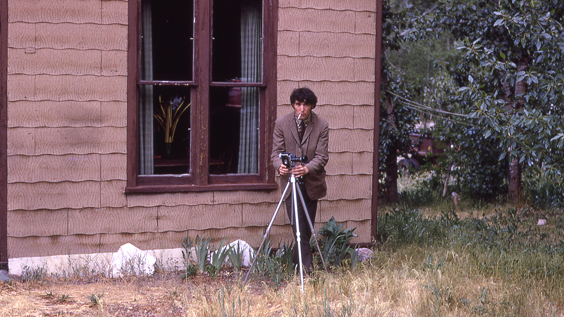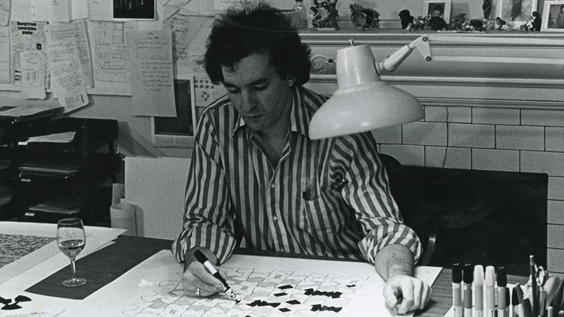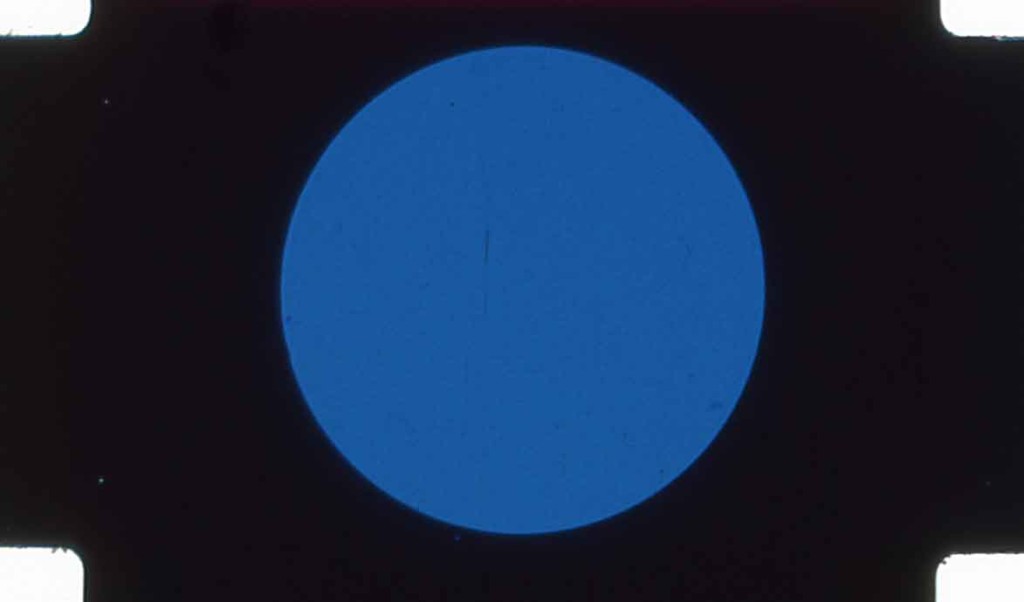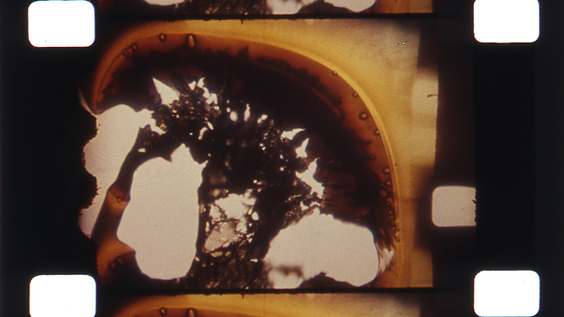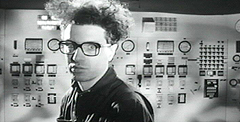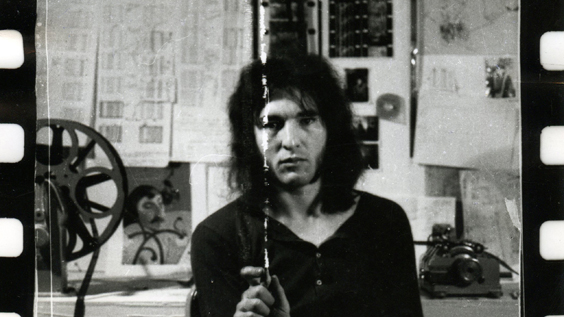S:HA:S:S:HAR:S:HARRR:S:S:HARITS
S:HA:S:S:HAR:S:HARRR:S:S:HARITS
Discussing Paul Sharits with filmmaker François Miron
François Miron is a prolific French Canadian experimental filmmaker whose works employ strategies involving image manipulation, with a focus on optical/visual experiments made using the optical printer. His newest film Paul Sharits (2015) is an engaging portrait of one of the key figures of the American avant-garde cinema and recently premiered at 44th International Film Fest Rotterdam. The documentary is a delicate balance between Sharits’ personal struggles with manic depression and bi-polar disorder, his artistic practice, and the mythology surrounding the artist. In this written interview (conducted via e-mail with minor revisions), we discuss Miron’s work, Paul Sharits, psychedelia and other related matters.
++++
Clint Enns: What was the impetus for this documentary?
François Miron: I had been sitting on this project for a long time and when I would start to think about a new short film or about a new concept or idea, Sharits would always be present in the back of my mind. I wanted to do something complete and I thought about how to approach this subject. At first, it was going to be a short film, but there was no way that I could say everything that I wanted to and to demonstrate the importance of Sharits in a short format work. Eventually, I got funding for a short, however, that eventually turned into funding to make it into a feature. The whole process took a long time.
CE: Have you ever met Sharits? What was your personal experience of him?
FM: There are several answers to these questions. The most important one dates back to 1979 or 1980. I was on a trip to NYC and there was a screening of Razor Blades (1965–68), that was shown as a double screen projection with extremely loud sound. I was around 17 and I knew nothing about experimental film, never mind that flicker films and double projection set ups where being created. This experience changed me. At the time, I was leading a pointless existence, but seeing this film took me on a journey; it was a trigger and I could relate to the material in an extremely intimate way. Although some people walked out of the screening angry, I wanted the movie to go on longer, to be even more extreme. It spoke to me and changed the rest of my life. Shortly after that I began making films and here I am now, still making them. A life in cinema simply because I saw this Sharits screening. (see an excerpt from Razor Blades HERE)
In terms of meeting him, I did a phone interview with him in 1985 (or 86) for a school project. We mostly talked about psychedelia, perception and colour. He was extremely brilliant and articulate, however, the audio was lost and the other student who had it died a few years ago. I tried to track it down but no one has a copy. Sharits turned me on to the book The Living Brain by William Grey Walter, and the infamous chapter “Revelation by Flicker.” He also provided me with several references to films, painting, sculpture and architecture.
He visited the School of the Art Institute of Chicago (not an official visit) while I was completing my masters (1988 or 89). I showed him some of my films, and he really liked them. At the time, I even mentioned to him the idea of a documentary, but sadly, a few years later he passed away.
CE: What are some of your favourite Sharits anecdotes?
FM: There are too many! Some are entertaining and funny but some are sad and violent. I’ve seen people take delight in the violent ones however, I’m usually not one of those people. With that, here is an exception:
Often Sharits’ violent actions where perceived as crazy acts of drunken violence, but to me it is far more complex. That is, it seems closer to the performance art of someone like Chris Burden. I like the anecdote about the Nam June Paik piano destruction. It was at some big event and Paik had a piano set up to trigger video images for a performance. At some point, Sharits sat down at the piano and began to play it and by playing it, I mean he was pounding on the keys hard enough to break his bones and to cut himself up pretty badly. That night, he made a statement and everyone who was there will remember that gesture more than Paik’s piano. In other words, the act is more art historically important than Nam June Paik’s video piano…the structuralist filmmaker passionately destroying the video-making device.
CE: This seems like the aggression cinematically explored in T,O,U,C,H,I,N,G (1968) (with “destroy” looped-repeatedly on the soundtrack) physically realized.
FM: Another one of my favourites is by MM Serra of the Filmmakers Coop in New York. She once went to a screening of Paul’s work and there was some guy sitting in the front row being extremely disruptive. He was talking, screaming and loudly eating popcorn, so she finally tapped him on his shoulder and when he turned around…it was Paul.
I also like the story of how he tried to set the Anthology Film Archives on fire. He wanted people to remember it as that, to entertain a myth. So he went into the bathroom and began setting pieces of fabric on fire. There is no way that the building would actually catch fire, it was totally planned. There was always a method in his madness.
CE: Your film The Gap In The Curtain (1989) is an explicit homage to Sharits that at first employs his techniques, but eventually moves past them to conduct new experiments with visual perception. Can you talk about the specific influence Sharits has had on your body of work?
FM: Sharits definitely influenced my use of film scores and my interest in frame-by-frame colour harmonics/resonance. In addition, the color palette that I used in several of my early optical printing films stem from that approach…albeit I used them completely differently.
In addition, the image/word structure that is present in Kick That Habit Man (1988) is also heavily Sharits-influenced. That is, each word is linked to an image based on a permutation poem by Brion Gysin and read by Monte Cazazza.
It is safe to say his entire philosophy has been influential on my work. I probably wouldn’t have set up multi-projection screenings of my work in San Francisco in the 90s if I hadn’t seen his work. In fact, I later carried these over in my collaborations with the band Godspeed You! Black Emperor, where one of the members was a former student of mine and also really into Sharits.
Sharits’ expressions and his manner of explaining things, of being really open, has influenced my teaching style and probably how I am as a person. I think it is even possible to see the influences in my narrative feature The 4th Life (2006) specifically in the way the film deals with tension and perception.
CE: In 4X Horizontal, 4X Vertical (1986) you are concerned with systematically mapping out and destabilizing screen space, a theme that Sharits was also interested in.
FM: Yes. The combination of geometric precision and structural permutations are much more from Sharits than, let’s say, Gysin or Burroughs – even though I am an admirer of their work as well. The presence of the filmmaker re-arranging the screen is akin to Sharits and Fran (his wife) standing up frozen in Razor Blades, something that I’ve realized only recently.
CE: Can you explain the connection between your interest in psychedelia and visual perception?
FM: This is a vast subject, but I remember being asked at the Goethe Institute in the mid 90s how I began making films. I explained that I had done LSD and was simply trying to record on celluloid the visions and the hallucinations I had seen while tripping. The sad part is that the audience actually believed it. They thought I was serious.
The truth is I believe in altered perception and psychedelic experience as code, as a style of language, as elements one can use in a sophisticated way in order to make complex works of art. Ideally, I see some of my films as a gateway, or as a portal to some sort of state akin to that of psychedelic bliss, and this has little or no connection with actual drug use.
The psychedelic aesthetic has always been a turn on for me, whether in design, music or films (narrative, experimental, or otherwise).
CE: Was the translation to video difficult for you given your material approaches to filmmaking? Can you talk about your transition from experimental cinema to documentary filmmaking?
FM: I never actually transitioned to video – I hate video! What we have now as an acceptable replacement for film is digital cinema. Once video became high-resolution and it became possible to work frame by frame, I became simply OK with it. Although it is approaching a filmic aesthetic, I still have many issues with it.
I guess the first transition in style came with Resolving Power (2001), a film involving actors and a more traditional approach to linearity. The film starred Rick Trembles and featured some of his animations. Back in 1992 or so, I showed up on a set to play an extra (I don’t know what I was thinking…as far as I know the film never came out). They wanted the stereotypical long-haired stoner looking dude and they cast myself and Rick, so we met on that set. He later did some title animation for my film The Evil Surprise (1994). His animations were old school – frame by frame drawing which involved drawing and inking each image.
Anyways, the major transition happened with my narrative feature The 4th Life, which involved working with many actors, narrative arcs, big crews, big sets et cetera. The transition was simply a natural step in my creative process. It is the years of experience and intention that is important. Labels like “narrative,” “documentary” or “experimental” not so much.
CE: It seems clear that all of those years of developing a found footage aesthetic was helpful for structuring Sharits.
FM: Sharits is heavily archive reliant. I am used to working with stock footage, since I have edited all my films for the last 32 years. Capturing and gathering the “talking heads” was quite an odd experience for me, but I viewed them as just another raw material to add to the pile of objects and textures to create the final work. Some have a creative visual approach where I had time to apply my own aesthetics to the shots, others have less because of time limits given by the participants. Since I had so many sources for images, I came up with the “blocks of ideas” treatment for the structure from my main research assistant Jean-Francois Martin. The film was simply a question of putting a gigantic puzzle together.
CE: The soundtrack for the film is quite ominous, creating an atmosphere of impending doom. Can you talk about the sound design by Felix-Antoine Morin, and how you approach choosing a soundtrack in general for your work?
FM: The process is essentially a collaborative one. The sound designer must really be in tune with what you are doing, especially on a spiritual/emotional tone. We started working on specific sections together and once the atmosphere was set, the rest came naturally. It was not an obvious or easy film to design sound for and I have to say that Felix A. had a very special perception; this is what made it possible.I had the similar relationship with David Kristian who constructed the design for The 4th Life, although the result and atmosphere is quite different.
CE: I wonder what the fate will be of all the extra content generated for this documentary. Is there any plan to make the full interviews available? Is there a DVD or NetFlix release scheduled?
FM: Yes, there is a huge amount of stuff that is really interesting that has to be seen by people. I plan to make some of the full interviews available.A curator recently suggested that this film could be made into an interactive installation where the full films of Sharits could be seen as well as full interviews, all of the pictures, drawings, schematics, etc. I’m open to that concept. There will be a Bluray release and a DVD, but I want the film to tour for quite a while before releasing those.
++++
François Miron’s OFFICIAL WEBSITE
Paul Sharits OFFICIAL FILM WEBSITE
Special thanks to Mark Loeser for our experimental film discussions over backgammon and for introducing me to François Miron’s films.

 April 20, 2015
April 20, 2015  1 Comment
1 Comment
